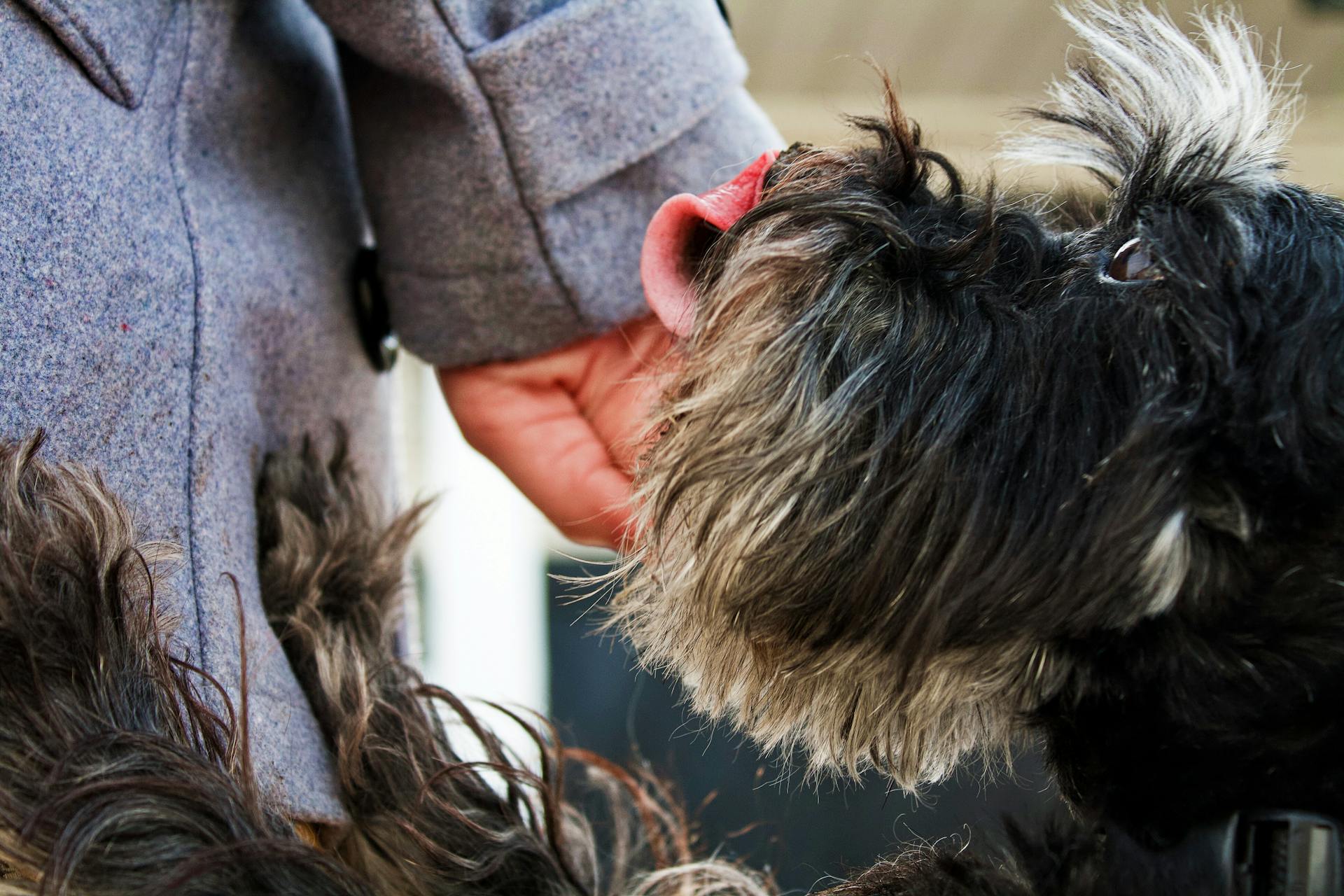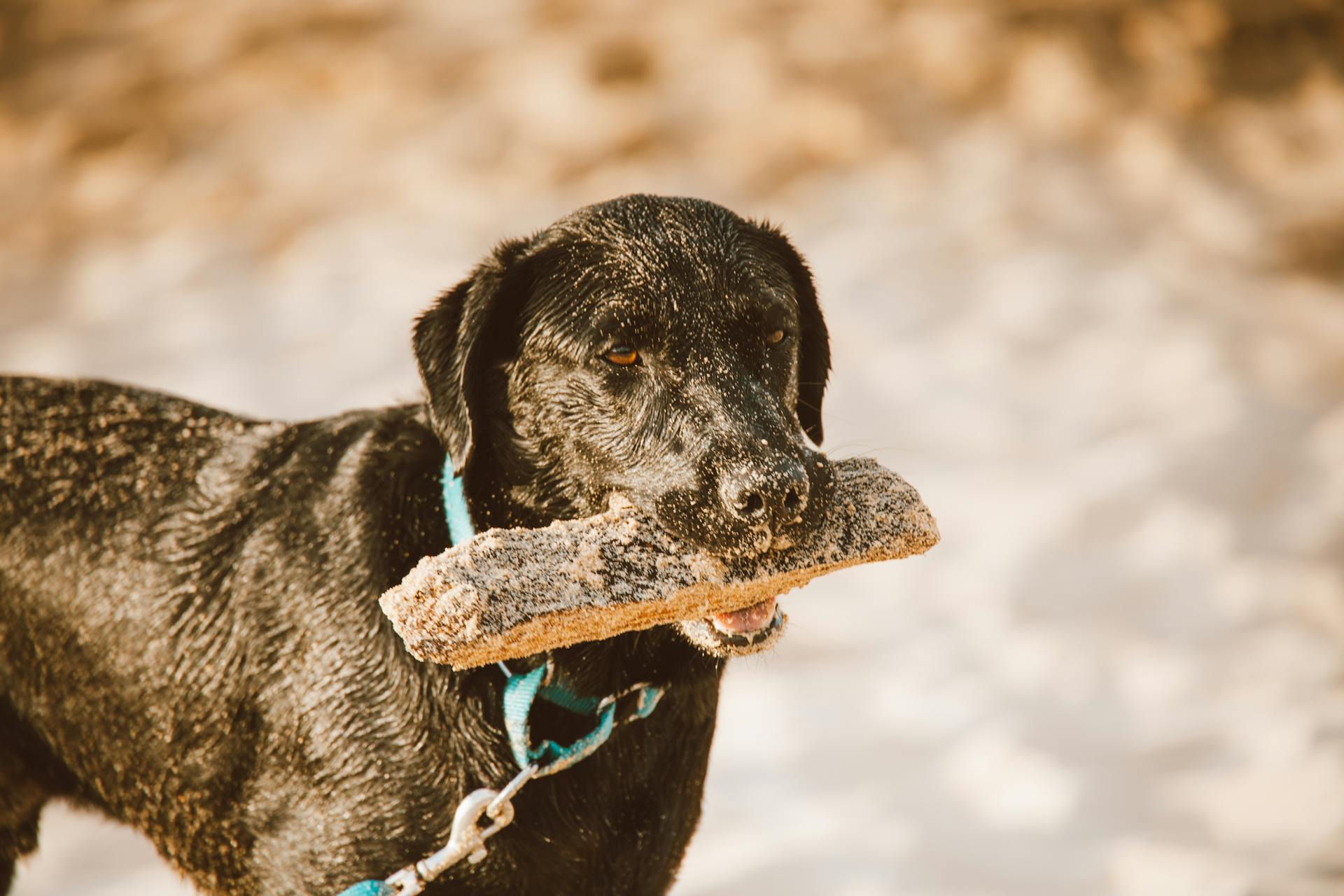
If you're considering a prong collar for your dog, it's essential to explore alternative options that prioritize their comfort and safety. Prong collars can cause physical pain and discomfort, which can lead to long-term behavioral issues.
Some owners have reported using head halters as a humane alternative, which can help with walking and training by gently steering the dog's head. A well-fitted head halter can be an effective tool for managing pulling behavior.
However, it's crucial to introduce head halters gradually and under controlled conditions to prevent overwhelming your dog. This can help prevent the development of anxiety or fear-based behaviors.
For dogs that are prone to pulling, harnesses can be a great alternative to prong collars, providing a more comfortable and secure fit.
You might like: Alternatives to E Collar for Cats
Prong Collar Alternatives
Positive Reinforcement is a great alternative to prong collars, focusing on rewarding good behavior with treats, praise, and toys. This approach strengthens the bond between you and your dog.
Clicker Training is another effective method, using a clicker to mark desired behaviors and associate them with rewards. It's a great way to enhance communication and speed up the learning process.
Force-Free Training techniques, such as shaping and capturing, encourage dogs to engage in desired behaviors voluntarily, without resorting to fear or pain.
Pros and Cons
Positive reinforcement training methods like clicker training and force-free training are effective alternatives to prong collars. They promote voluntary behavior and strengthen the bond between you and your dog.
Reward-based training using treats, praise, and toys can lead to long-lasting behavioral changes. This method is especially useful for dogs that respond well to positive reinforcement.
Professional trainers who practice force-free training methods can provide expert guidance tailored to your dog's unique needs. They can help you develop a customized training plan that's both effective and ethical.
Shaping and capturing are force-free techniques that encourage dogs to engage in desired behaviors voluntarily. These methods are a great alternative to prong collars that rely on fear or pain.
Clicker training can speed up the learning process by marking desired behaviors with a clicker. This technique enhances communication between you and your dog, making it easier to understand each other's needs.
Exploring Safer Alternatives
Positive reinforcement training is a great way to promote good behavior in your dog without the need for prong collars. Reward-based training using treats, praise, and toys associates actions with positive outcomes, strengthening the bond between you and your dog.
Clicker training is a technique that uses a clicker to mark desired behaviors, followed by a treat or reward. This method enhances communication and speeds up the learning process.
Professional trainers can provide expert guidance tailored to your dog's unique needs, ensuring effective and ethical training. They practice positive reinforcement and force-free training methods, which are safer and more humane alternatives to prong collars.
Force-free training techniques like shaping and capturing encourage dogs to engage in desired behaviors voluntarily, without resorting to fear or pain. This approach is not only safer for your dog but also builds trust and strengthens your relationship.
Zoom Room Dog Training is a great resource for learning positive reinforcement techniques and force-free training methods. Their expert trainers can help you develop a customized training plan that suits your dog's needs and personality.
Broaden your view: Bark Collar Great Pyrenees
Types of Harnesses
Standard harnesses can be a game-changer for dog owners, as they help reduce the risk of injuries to dogs who pull on the leash.
There are 3 main types of harnesses used for walking dogs: Standard harnesses, No-pull harnesses, and other specialized harnesses that can help with training.
Standard harnesses are a great option for everyday walks, while No-pull harnesses can be particularly helpful for dogs that tend to pull a lot.
For more insights, see: How Do I Stop My Dog Pulling on the Lead
Harnesses
Harnesses are a crucial investment for dog owners, as they can significantly reduce the risk of injuries to dogs who pull on the leash.
Standard harnesses are a great starting point, as they can help prevent neck strain and discomfort in dogs. No-pull harnesses can also be an effective tool for training your dog not to pull at all.
There are three main types of harnesses used for walking dogs. Back-clipping harnesses are an excellent option for small dogs or those who don't tend to pull hard on the leash.
For your interest: Dog Training Lead Leash
However, for dogs that tend to pull, back-clipping harnesses can actually encourage pulling by engaging the dog's opposition reflex. This is why a chest-led harness is often a better choice for these dogs.
Chest-led harnesses, such as no-pull harnesses, can actually help train your dog not to pull at all. They work by distributing the force of the leash across the dog's chest, rather than their neck.
Head Halter
Head halters, also known as head collars, are a type of harness that can be a game-changer for dogs who pull hard on leash. They work by moving the point of attachment from the dog's neck to the dog's head, giving the handler greater physical control.
To use a head halter safely, it's essential to fit it properly to your dog. The Humane Society of the U.S. recommends making sure the head halter is snug around your dog's neck and high behind his ears, but loose enough around his nose so that the nose strap can slide easily down to the fleshy part of his nose.
Head halters can be a safer alternative to aversive training collars, but they're not suitable for every dog. According to Dr. Sophia Yin, few cases of injury due to head halters have been proven or medically documented, but veterinary-documented injuries caused or exacerbated by choke chain corrections and electronic collars are common.
Some dogs may find head halters mildly to extremely aversive, so it's crucial to acclimate your dog to wearing one before you begin using it. This can take some time and patience, but with positive reinforcement and treats, most dogs learn to quickly associate the head halter with good things.
Here are some tips for safely using a head halter:
- Never use a hard jerk with the head halter
- Outfit your dog with the head halter only during on-leash walks with you and when you're directly supervising him
- Don't allow your dog to wear the head halter around the house
- Be sure to read the information sheet that comes with the head halter
By following these guidelines and taking the time to properly condition your dog to a head halter, you can help your dog learn to walk nicely on leash while reducing the risk of injury or aversive behavior.
Martingale Collar
Martingale collars are great for preventing dogs from backing out of their collars, especially for breeds like Greyhounds whose narrow heads make it easy for them to slip out.
They're also a good choice for thick-necked dogs like Bulldogs, whose necks are as wide as their heads are large.
The martingale collar should be fitted so that when the dog pulls, it tightens just enough to prevent the dog from backing out of it, but not so tight that it chokes or restricts breathing in any way.
Other Collar Options
If you're looking for other collar options, consider a harness. A harness can be a more comfortable and safe alternative to a prong collar, especially for dogs with sensitive skin.
Some harnesses are designed specifically for walking and training, with features like padded chest plates and easy-to-use buckles.
A head halter is another option that can be effective for some dogs. By gently redirecting a dog's head, a head halter can help to discourage pulling on the leash.
For another approach, see: Martingale Collar vs Harness
Pet Accessories
Prong collars are a type of training collar that applies uncomfortable pinching pressure to a dog's neck to prevent pulling on the leash.
They are designed to be placed high up on the most sensitive part of the dog's neck, just behind the ears, and can cause pain and discomfort while walking.
Prong collars can make behavioral situations worse in dogs who are already nervous and reactive, as the pain from the collar can negatively reinforce their fear.
In fact, if a dog is fearful of other dogs and encounters one coming towards him, the pain from the prong collar can increase his fear and make him even more reactive.
Even friendly dogs can get mixed signals from a prong collar, causing them to bark and lunge more when they see their playmates approaching.
Prong collars can also cause physical damage, especially if they are placed too low on the neck, similar to choke collars.
The pinching action of the collar is often compared to a mother dog grabbing a puppy's neck to make a correction, but there is no scientific evidence to support this claim.
Prong collars are not a recommended option for training or walking dogs, especially those who are already nervous or reactive.
If this caught your attention, see: Head Halter for Reactive Dogs
Flat Collar
You can choose from various materials for a flat collar, such as leather, nylon, or cloth, and even pick from a range of colors and patterns.
A properly fitted flat collar should allow you to slip two fingers under the collar, perpendicular to the dog's neck.
Flat collars are suitable for everyday use, like holding ID tags and for general walking and training purposes.
If your dog is a dedicated puller, however, a front-clip control harness is a better choice for walks and training, until she learns to stay close to you.
You can even get flat collars with special features like buckles, snaps, or reflective materials.
Try Citronella or Vibration
Try Citronella or Vibration Collars as a gentler alternative to shock collars. They're designed to interrupt your dog's behavior without causing physical pain.
Citronella collars release a burst of citronella when your dog barks, which many dogs dislike and promptly quiet down. This is because the smell of citronella is unpleasant for many dogs.
Vibration collars, on the other hand, use a strong vibration effect or high-pitched noise to get your dog's attention. They're also used to aid in training deaf dogs, as they can view hand signals.
While these devices aren't as popular as other options, they can be effective in managing behavioral issues. However, we'd still recommend trying other alternatives first.
If you do decide to use a correction collar, at least citronella and vibration collars are a little more gentle than shock collars. They're still aversive, but they don't cause physical pain.
For another approach, see: Vibration Collar vs Shock Collar
Other Options to Consider
Reducing neck strain is a significant concern for dog owners, especially those with dogs that pull or have respiratory issues. Traditional collars can put strain on a dog's neck, but harnesses distribute pressure across the chest and shoulders, reducing the risk of neck injuries and discomfort during walks.
Harnesses provide better control over a dog's movements, making them ideal for larger or stronger dogs. They discourage pulling by redirecting the force towards the body, allowing for a more comfortable and manageable walking experience.
A fresh viewpoint: How Does a No Pull Dog Harness Work
Harnesses like the Easy Walk Harness have a front attachment point that redirects a dog's attention towards the handler when they pull, encouraging them to walk beside instead of pulling ahead. This helps in teaching loose-leash walking manners.
Minimizing pulling behavior is crucial for a smooth walking experience, and Easy Walk Harnesses discourage pulling by causing the dog to turn their body when they try to pull. This makes it easier to train dogs not to pull on the leash and promotes better leash manners.
Harnesses like the Gentle Leader work by fitting around a dog's nose and behind their ears, allowing the handler to control the dog's head and influencing their direction. This discourages pulling without causing discomfort.
Expand your knowledge: Prong Collar Causing Sores
Safety Considerations
Using prong collars or choke chains can lead to physical and emotional damage, causing discomfort, pain, fear, confusion, and aggression in dogs.
Prong collars can cause injuries such as punctures, bruises, and skin irritation, while electric shock collars can result in burns and other physical harm if not used properly.
These tools can also lead to suppressing a dog's behavior rather than teaching them the desired behavior, making it difficult to break the cycle of aversive corrections when dealing with challenging behaviors.
Chronic activation of stress systems can damage the hippocampus, leading to chronic dysregulation and the potential overproduction of stress hormones, making the dog's brain vulnerable to excitotoxicity and stress reactions.
The use of prong and shock collars can create a hostile training environment, damaging the trust and bond between the dog and its owner, and may even lead to long-term behavioral issues.
Safety Dog
Traditional collars can put strain on a dog's neck, especially for dogs that pull or have respiratory issues.
Harnesses distribute pressure across the chest and shoulders, reducing the risk of neck injuries and discomfort during walks.
Breakaway dog collars have a mechanism that releases under pressure, preventing accidental hanging or choking, but they can come open if grasped suddenly in an emergency.
Positive reinforcement techniques, like reward-based training, promote positive behavior by associating actions with positive outcomes, strengthening the bond between you and your dog.
Clicker training and force-free training methods, such as shaping and capturing, encourage dogs to engage in desired behaviors voluntarily, without resorting to fear or pain.
Reducing neck strain is a significant safety consideration for dogs, especially those with respiratory issues, making harnesses a safer alternative to traditional collars.
Gentle Leaders work by fitting around a dog's nose and behind their ears, allowing the handler to control the dog's head and discouraging pulling without causing discomfort.
Easy walk harnesses have a front attachment point that redirects a dog's attention towards the handler when they pull, encouraging them to walk beside instead of pulling ahead.
Explore further: Dog Training Harness for Pulling
Potential Risks Associated
Using prong, choke, and shock collars can lead to physical and emotional damage in dogs. These tools can cause discomfort, pain, and even injuries such as punctures, bruises, and skin irritation.

Dogs exposed to electric shocks or prongs can develop anxiety and fear, leading to avoidance behaviors and a diminished quality of life. This can be a result of the chronic activation of their stress systems.
Prong and shock collars can also lead to increased aggression in dogs, particularly when they associate the pain with certain people, animals, or environments. This is a serious concern for dog owners and trainers.
Rather than addressing the root cause of unwanted behaviors, prong and shock collars suppress symptoms, potentially exacerbating underlying problems. This can create a cycle of aversive corrections that's difficult to break.
The discomfort and pain caused by these collars can lead to negative associations with dogs, even in social settings. For example, if a prong collar is left on a dog after the leash is removed, the dog may experience pain and punishment when engaging in positive play with another dog.
Positive Training Methods
Positive Training Methods are a game-changer for your furry friend's well-being and your relationship with them. You can ditch the pain and punishment approach in favor of something much more effective and enjoyable for both of you.
Training treats are a simple yet powerful way to reward good behavior. They need to be something your dog really loves, so choose their favorite snacks and store them in a treat pouch to keep your hands free.
Verbal praise is another great way to show your dog what a good boy or girl they are. Use your voice to tell them how proud you are, and keep your tone upbeat and consistent so they associate it with a job well done.
Games can be a fun way to reward your dog for a successful training session or reaction-free walk. Try playing fetch or another favorite activity to keep the good mood going and strengthen your bond.
Toys can be a nice change of pace from treats, and they're especially useful if your dog "places" or "kennels" on command. Offering a fun toy can help them associate the command with something positive.
Clickers can be a helpful tool in teaching your dog commands, especially "sit" or "place." They work best when used in conjunction with high-value treats, so make sure to associate the clicker with something positive.
Here are some popular positive training methods you can try:
Key Takeaways
Prong collars cause your dog physical discomfort, which can lead to fear, anxiety, or even aggression. The pain or discomfort caused by prong collars can be intense enough to stop undesired behavior, but it's not a long-term solution.
Prong collars can be effective in some situations, but often, they're a temporary fix for deeper issues that need attention. I've seen owners use prong collars to correct behavioral problems, but it's a patchwork solution that doesn't address the underlying causes.

There are many better training alternatives available that can achieve better results without causing harm to your dog. These alternatives focus on positive reinforcement and building trust, rather than relying on pain or fear.
Here are some key takeaways to consider:
- Prong collars can cause physical discomfort or pain to your dog.
- Prong collars can be effective in some situations, but often, they're a temporary fix for deeper issues.
- Better training alternatives exist that can achieve better results without causing harm to your dog.
Exploring Alternatives
Positive reinforcement training is a pain-free and effective way to strengthen the bond between you and your dog, leading to long-lasting behavioral changes.
Reward-based training using treats, praise, and toys promotes positive behavior by associating actions with positive outcomes.
Clicker training involves using a clicker to mark desired behaviors, followed by a treat or reward, which enhances communication and speeds up the learning process.
Force-free training encourages dogs to engage in desired behaviors voluntarily, without resorting to fear or pain, using techniques like shaping and capturing.
Enlisting the help of a certified, professional dog trainer who practices positive reinforcement and force-free training methods can provide expert guidance tailored to your dog's unique needs.
The Humane Hierarchy of Animal Training outlines five levels of intervention that should be considered when working with animals, from prevention to replacement, with the goal of minimizing animal suffering and optimizing their welfare.
LIMA, or Least Intrusive, Minimally Aversive, is a behavior modification training strategy that utilizes the least invasive and least aversive methods available to prompt desired behaviors in animals.
Simpawtico Dog Training recommends LIMA training, starting with the least intrusive and minimally aversive methods available, to ensure effective and humane training.
Understanding Effectiveness
A prong collar alternative's effectiveness can be measured by its ability to address specific behavioral issues without causing physical harm or discomfort.
The Head Halt harness is designed to discourage pulling by applying gentle pressure to the dog's chest and shoulders, rather than their neck.
It's essential to remember that every dog is unique, and what works for one may not work for another.
The Easy Walk Harness reduces the dog's ability to pull by distributing the force across their chest and shoulders, making it more difficult for them to move forward.
This makes it an excellent option for dogs that are prone to pulling on their leash.
Proper fitting and adjustment of the harness are crucial to ensure its effectiveness.
A well-fitted harness can make a significant difference in the dog's behavior and the owner's experience.
The Halti Head Harness works by applying gentle pressure to the dog's muzzle, which helps to discourage pulling and redirect their attention.
By addressing the underlying issue of pulling, these alternative tools can help to strengthen the bond between dog and owner.
Red Zone Dogs
Red Zone Dogs can be rehabilitated with patience and the right techniques. They often exhibit unpredictable behavior due to trauma experienced from cruelty or neglect. These dogs are typically unsuitable for adoption and require experienced handlers. They can be rescued from cruelty or neglect.
Aversive training is not necessary to modify their behavior. In fact, it can be detrimental to their emotional and mental well-being. We have successfully worked with many Red Zone Dogs.
Frequently Asked Questions
Do vets recommend prong collars?
Vets do not recommend prong collars due to the risk of severe skin and muscle inflammation, as well as potential cervical spine injuries. Instead, consult with a veterinarian to find a safe and humane training solution for your pet.
Are prong collars inhumane?
Prong collars can cause physical discomfort, pain, and stress in animals, compromising their welfare. Using prong collars is considered inhumane due to the potential harm they can inflict on animals.
Is a martingale collar better than a prong collar?
A martingale collar is not inherently better than a prong collar, as it requires significantly more force to achieve similar effectiveness and may pose a higher risk of injury. However, it can be a suitable alternative for dogs with narrow heads, offering a safer restraint option.
Sources
- https://www.goodpetparent.com/2015/07/17/choke-prong-shock-collars/
- https://www.whole-dog-journal.com/care/collars-harnesses-leashes-muzzles/the-safest-types-of-dog-collars-and-the-most-dangerous/
- https://www.k9ofmine.com/shock-collar-alternatives/
- https://spcanevada.org/harmfulcollars/
- https://www.simpawtico-training.com/building-better-behavior-without-prong-collars-or-choke-chains/
Featured Images: pexels.com


